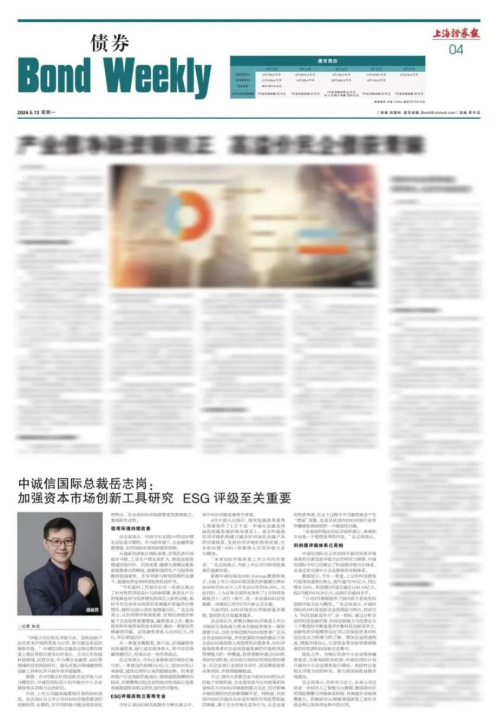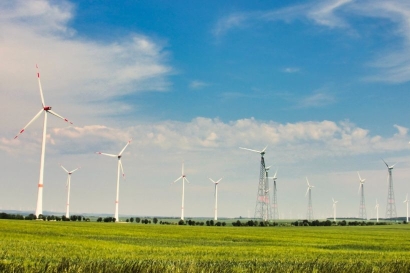
"Rating agencies should optimize rating methods, accelerate the popularization and application of innovative products in the capital market, and help build a multi-level bond market." Yue Zhigang, president of China Chengxin International, said in an interview with a reporter from Shanghai Securities News that the company is strengthening credit risk research in the fields of science and technology innovation, private enterprises, financing of small and medium-sized enterprises, ESG, etc., strengthening research on innovative financing tools in key areas and carrying out special rating services.
It is reported that after launching the rating methods and models for science and technology innovation enterprises in April, China Chengxin International also plans to carry out research on rating methods related to small and medium-sized enterprise bonds.
Currently, listed companies are paying more and more attention to their ESG performance. Yue Zhigang believes that the demand for ESG ratings by listed companies is still rigid and long-term, and may show differentiated characteristics at different stages, but in the future, ESG ratings need to pay more attention to independence, objectivity and professionalism.
Credit environment continues to improve
Yue Zhigang said that China can expect to achieve its GDP growth target of 5% this year. In the current environment, companies are more willing to raise funds and credit risks are expected to be better controlled.
Judging from the latest economic statistical indicators, the macro-economy has started smoothly, industrial production growth has expanded, and the growth rate of manufacturing investment has accelerated. In the future, with the release of the effects of large-scale equipment renewal policies, equipment manufacturing production and investment will maintain strong resilience, and infrastructure investment will continue to play a bottoming role under the support of special bonds and special government bonds.
"This year's Government Work Report has made targeted top-level designs and specific deployments for some bottlenecks. The development of new quality productivity will also continue to inject new impetus into economic growth. I believe that this year's economy will achieve effective improvement in quality and reasonable growth in quantity, and successfully complete the annual growth target of 5%. "Yue Zhigang said that judging from the performance of the credit bond market, with the steady recovery of the macro economy, companies' willingness to invest has increased, financing demand has increased, and the cost benefits brought by the low interest rate environment have driven a rebound in credit bond financing in the first quarter, achieving a net inflow of financing of 433.9 billion yuan, a significant year-on-year and month-on-month increase.
Judging from the data at the end of the first quarter, the financing conditions in various industries and regions have generally improved, with more than 70% realizing net inflows. Among them, the net financing amount of real estate companies turned positive, ending a year-long net outflow.
Yue Zhigang said that the bond default risk has been generally controllable since the beginning of this year, with the default scale of 3.49 billion yuan in the first quarter, a new low since 2016, continuing the slowdown trend in the past two years. However, considering that the risks in the real estate industry are still high and the scale of bond extensions is still high, we still need to be vigilant about the liquidity risks of companies in trouble and the possibility of substantial defaults due to the obstruction of bond extensions.
ESG ratings should be independent, objective and professional
Since the beginning of this year, ESG-related policies have been continuously improved, and ESG ratings have also been highly anticipated.
In April, the People's Bank of China, the National Development and Reform Commission and seven other ministries and commissions issued the "Guiding Opinions on Further Strengthening Financial Support for Green and Low-Carbon Development". The document encourages credit rating agencies to establish and improve a rating system for green financial products and supports credit rating agencies to incorporate environmental, social and governance (ESG) factors into credit rating methods and models.
"ESG ratings will be an inherent requirement for listed companies in the future." Yue Zhigang said that the awareness of sustainable development among listed companies is gradually increasing.
According to the statistics of CCXGF ESG Ratings Database, the disclosure ratio of ESG-related reports of A-share listed companies will increase from 26.41% in 2020 to 35.39% in 2023. At the same time, the three major stock exchanges have also issued the "Sustainable Development Report" (Trial) Guidelines to further strengthen ESG information disclosure. The rules have been officially implemented in May.
At the same time, the application scenarios of ESG ratings have gradually been implemented and are receiving more and more attention.
Yue Zhigang believes that actively carrying out ESG ratings is an important way for listed companies to keep their own development consistent with the investment philosophy of the capital market. At present, ESG investors around the world are paying close attention to corporate ESG ratings, and driven by policies and markets, they incorporate corporate ESG performance into their investment decision-making references. ESG ratings are a measure of investors' value and risk management capabilities for high-quality development of companies. Investors expect to conduct a comprehensive and integrated evaluation of companies through the risk transmission mechanism of ESG, combined with their own credit risk management concepts, thereby reducing investment decision-making risks and obtaining excess returns.
However, most domestic companies are still in the early stages of understanding ESG. They are more likely to focus on ESG rating levels in response to policies and stakeholders, but they do not fully understand the internal factors that affect rating results. In particular, there is no effective market supervision and punishment measures for ESG ratings in China. It is a completely market-based competitive behavior. Considering the profit-seeking nature of enterprises, the phenomenon of "greenwashing" is inevitable in this process, which is also a challenging problem facing the orderly and healthy development of the domestic ESG rating industry.
"How to ensure the independence, objectivity and professionalism of ESG ratings in the future is something worth thinking about," said Yue Zhigang.
The rating system for sci-tech innovation bonds has been unveiled
China Chengxin International is also continuing to improve the existing rating system and research and explore new rating methods. This year, China Chengxin International has launched a rating method system for science and technology innovation bonds, and will also improve the rating system for small and medium-sized enterprise bonds in the future.
Data shows that in the first quarter of this year, the issuance of science and technology innovation bonds on the Shanghai Stock Exchange continued its rapid growth momentum, with an issuance volume of 75.5 billion yuan, a year-on-year increase of 184%. The trading volume of science and technology innovation bonds in March reached 124.159 billion yuan, an increase of 67.425 billion yuan from February, reaching a historical high.
"The company just released the country's first systematic science and technology innovation bond rating method and model in April." Yue Zhigang said that China Chengxin International, based on the risks and characteristics of science and technology innovation companies, introduced the indicator of "science and technology innovation competitiveness" for the first time. By analyzing the three dimensions of a company's science and technology innovation value, science and technology innovation capabilities and operating strength, the technological innovation competitiveness of the rated objects is comprehensively measured. The innovative rating model setting can enhance investors' understanding of the strength and potential of science and technology innovation companies, increase corporate transparency, enhance market confidence, and guide funds and other innovative resources to more accurately concentrate on high-quality science and technology innovation companies.
In addition, in order to respond to the bond financing needs of high-quality SMEs and improve risk prevention and control mechanisms, China Chengxin International plans to conduct research on the issuance of SME bonds, risk characteristics and related rating methods to help build my country's high-yield bond market.
Yue Zhigang said that in terms of research methods, the company will further combine artificial intelligence and big data in the future, continue to deepen the research and development of credit risk warning and rating systems, effectively improve rating warning capabilities, and actively study the application of new tools in the AI field in rating business and various businesses.






